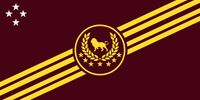Kado (Unified Sera)
Kado
K'ado | |
|---|---|
State | |
| Nickname(s): "The Jewel of the Union" (Official), "Doorway to the Sea" | |
| Motto: "Where the Sea Never Ends" | |
 Map of Unified Sera with Kado Highlighted | |
| Country | The United States of Sera |
| Capital | Kito'Bahari |
| Largest City | Kito'Bahari |
| Incorporated into Union | June 7th, 1741 |
| Government | |
| • Type | Representative Democracy (Republic) |
| • Body | State Legislature |
| • Governor | Rhonda Tepe (The Koga Centrist Party) |
| • Deputy Governor | Jamie Baast (K) |
| • Judiciary | First Federal District |
| • Secretary of State | Matthias Henry (M) |
| Area | |
| • State | 139,155 km2 (53,728 sq mi) |
| • Land | 83,298 km2 (32,162 sq mi) |
| • Water | 56,670 km2 (21,880 sq mi) |
| • Urban | 43,268 km2 (16,706 sq mi) |
| • Rural | 30,030 km2 (11,590 sq mi) |
| • Metro | 10,000 km2 (4,000 sq mi) |
| • Rank | 17th |
| Dimensions | |
| • Length | 564.87 km (350.99 mi) |
| • Width | 909.07 km (564.87 mi) |
| Elevation | 162 m (531 ft) |
| Population (2022) | |
| • State | |
| Demonym | Kadoan |
Kado kAY-doh; is a state located in the northern-most area of the United States of Sera and bordering the Jade Strait. Kado is known for being the "capital state" as it holds the official capital of the country Kito'Bahari within its borders.
Kado spans roughly 139,000 square kilometers in area thus making it the 17th largest state in the union by land area. Dotted with mountains and hills further inland and relatively flat, open ground closer to the shore, Kado's vibrant land and unique geography was made possible due to the changes in the Seran tectonic plate that wraps itself around the South Adulan sub-continent. Kado - by land area - has one of the smallest coastlines out of all the coastal Seran states.
The land that comprises Kado is mostly covered in thick vegetation, rivers, and several small lakes and streams strewn about the state. Known for its remarkable beaches and the immense history, Kado remains one of the most popular tourist locations in all of Unified Sera. Although other states bring in more tourist revenue and have more in by way of drawing revenue from the tourist industry, Kado remains a consistently popular destination.
Kado is also one of the most densely populated states and has a relatively large population living within the state. Most of this population lives on the coast, but there are rather large cities further inland that in recent years have begun to draw immigrants and Seran citizens to live in them.
Due to its political importance and coastal proximity Kado is one of the most ethnically, religiously, and culturally diverse places in the entire country. Large populations of Christians, Muslims, and those following other faiths and customs can be found within the state. Among those living in the state, there are also high numbers of immigrants and foreign workers within the state.
As a whole, Kito'Bahari (and by extension Kado) has the highest number of foreign workers than any other state in the Union. Only the states of (in order) Carthage, Rhodes, Aeminium, and Istrus come close as contenders in this category, with Carthage being the closest out of the group. As a result, Kado has the highest rate of individuals reporting to the Census that they are "two ethnicities or more" than any other location.
Etymology
The name for the state came about during the classical period of Seran history. Shortly after the region was settled by the Koga tribe, writings that showed the first usage of the word "K'ado" as a description of the land seemed to fundamentally be derived from a combination of other words meaning "land sea" or "sea shore". Scholars theorize that members of the Koga tribe therefore ascribed the word "Kado" to reference how important the sea and land was to their survival in this region.
Another possible theory involves the old paganistic religions practiced on the continent before the prevalence of the Sky Faith. These religions followed an overtly polytheistic structure and "Kado" could be a name for an old god or other deity that was present in the religion.
History
==
Geography and Environment
Demographics
Economy
Culture
Tourism
Health
Education
Transportation
This article is incomplete because it is pending further input from participants, or it is a work-in-progress by one author. Please comment on this article's talk page to share your input, comments and questions. Note: To contribute to this article, you may need to seek help from the author(s) of this page. |


